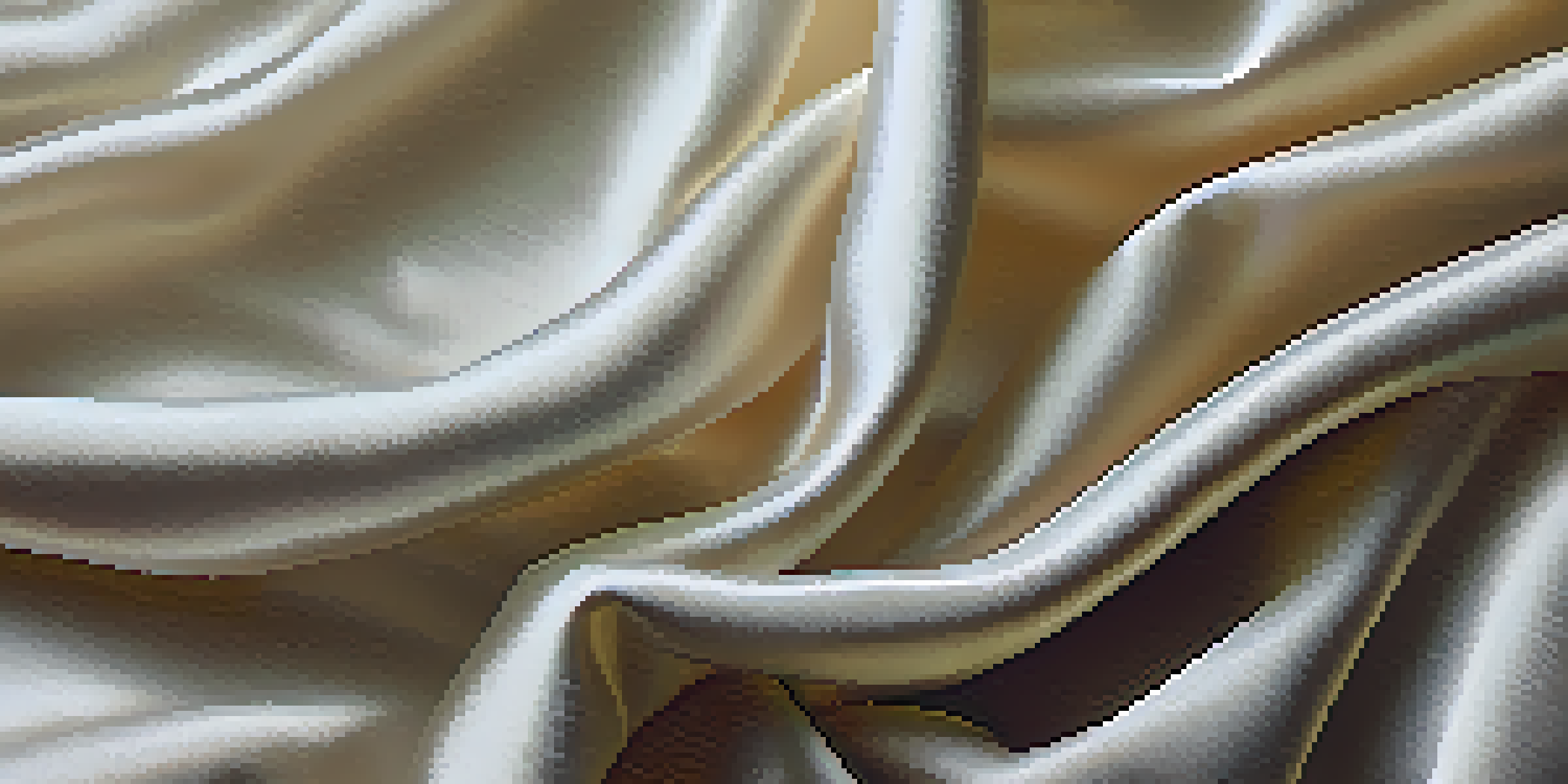Soy Fabric: A Sustainable Alternative to Traditional Textiles

What is Soy Fabric and How is it Made?
Soy fabric, also known as soy silk, is a textile made from the byproducts of soybeans. The process involves extracting protein fibers from the leftover pulp after oil extraction from soybeans, making it a sustainable option that utilizes waste materials. This innovative approach not only reduces textile waste but also provides a soft, luxurious feel similar to silk.
Sustainability is no longer about doing less harm. It's about doing more good.
The production of soy fabric is generally eco-friendly, as it requires fewer chemicals compared to traditional textiles. This means that the environmental impact is significantly lower, which is a huge plus for those who are conscious about sustainability. Furthermore, the process of creating soy fabric can also be less water-intensive, making it a great choice for eco-conscious consumers.
In summary, soy fabric is not just another textile; it's a smart solution that turns agricultural byproducts into something beautiful and useful. As the demand for sustainable materials grows, soy fabric stands out as a versatile alternative that meets both aesthetic and environmental needs.
The Environmental Benefits of Soy Fabric
One of the most compelling reasons to choose soy fabric is its positive environmental impact. By repurposing waste from soybean production, it significantly reduces the amount of textile waste entering landfills. This closed-loop approach not only conserves resources but also minimizes pollution associated with conventional textile manufacturing.

Moreover, soy fabric is biodegradable, which means that it will break down naturally over time. This is a stark contrast to synthetic fabrics, which can take hundreds of years to decompose. Choosing biodegradable options like soy fabric helps promote a more sustainable future, as they contribute less to the growing problem of plastic pollution.
Eco-Friendly Benefits of Soy Fabric
Soy fabric repurposes soybean waste, significantly reducing textile waste and pollution.
In essence, opting for soy fabric is a step towards a greener planet. Every purchase contributes to reducing waste and encourages more sustainable practices in the fashion industry, making a small but impactful change in how we approach clothing consumption.
Comfort and Versatility of Soy Fabric
Soy fabric is often praised for its luxurious feel and comfort. Its soft texture makes it an appealing choice for clothing items such as dresses, tops, and activewear. The fabric drapes beautifully, offering an elegant look while still being breathable and lightweight, perfect for various weather conditions.
The greatest threat to our planet is the belief that someone else will save it.
In addition to clothing, soy fabric is also used in home textiles like bed linens and towels. Its natural moisture-wicking properties help keep you dry, making it an excellent option for items that come in direct contact with the skin. This versatility makes soy fabric a favorite among designers looking to create eco-friendly collections across multiple categories.
Ultimately, the comfort and adaptability of soy fabric make it a practical choice for anyone looking to embrace sustainable fashion. Whether you're dressing up for an event or just lounging at home, soy fabric provides a combination of style and ease that is hard to beat.
How Soy Fabric Compares to Other Sustainable Textiles
When considering sustainable textiles, soy fabric stands out among other alternatives like organic cotton, hemp, and bamboo. While each of these materials has its benefits, soy fabric offers a unique combination of softness and durability that can be hard to match. This makes it a compelling choice for consumers who prioritize both comfort and sustainability in their wardrobe.
For instance, organic cotton is often praised for its low environmental impact, but it can sometimes lack the luxurious feel that soy fabric provides. Likewise, bamboo is known for its rapid growth and renewability, yet the processing methods can involve chemicals that detract from its sustainability. Soy fabric, on the other hand, utilizes a byproduct that would otherwise go to waste, making it an efficient option.
Comfort Meets Versatility
With its luxurious feel and moisture-wicking properties, soy fabric is ideal for clothing and home textiles.
By understanding how soy fabric compares to other sustainable materials, consumers can make informed choices that align with their values. This knowledge empowers individuals to select textiles that not only look good but also contribute positively to the environment.
Caring for Soy Fabric: Maintenance Tips
Caring for soy fabric is relatively easy, allowing you to enjoy its benefits without much hassle. To maintain its softness and appearance, it's best to wash soy fabric in cold water on a gentle cycle. This helps preserve the fibers and keeps the fabric looking its best for longer periods.
Avoid using harsh detergents or bleach, as these can damage the fibers and affect the fabric's quality. Instead, opt for mild, eco-friendly detergents that are gentle on both the fabric and the environment. Additionally, air drying is recommended to prevent shrinkage and to maintain the fabric's shape.
By following these simple care tips, you can extend the life of your soy fabric garments and enjoy their comfort and sustainability for many years to come. Remember, taking care of your clothing is an important part of embracing sustainable fashion.
Soy Fabric in the Fashion Industry: Current Trends
The rise of soy fabric has not gone unnoticed in the fashion industry, with many designers incorporating it into their collections. As consumers increasingly demand sustainable options, brands are responding by exploring innovative textiles like soy fabric. This trend reflects a broader movement towards eco-conscious fashion that prioritizes both style and sustainability.
Fashion designers are using soy fabric in various ways, from casual wear to high-end couture. Its versatility allows for creative expression, enabling designers to create unique pieces that stand out while also being environmentally friendly. As more brands adopt soy fabric, it becomes a symbol of the changing landscape of fashion towards a more sustainable future.
Growing Trend in Fashion
As sustainability becomes a priority, soy fabric is gaining popularity among designers and consumers alike.
In conclusion, the current trend of using soy fabric in the fashion industry highlights the growing awareness of sustainability. As designers and consumers alike embrace this eco-friendly material, soy fabric is poised to become a staple in conscious fashion.
The Future of Soy Fabric and Sustainable Textiles
Looking ahead, the future of soy fabric appears promising as the demand for sustainable textiles continues to grow. With increasing awareness of environmental issues, consumers are actively seeking alternatives to traditional fabrics that contribute to pollution and waste. This shift presents an opportunity for soy fabric to establish itself as a leading choice among sustainable options.
Research and development in textile innovation are likely to enhance the properties of soy fabric even further. As technology advances, we may see improved durability, color retention, and even more eco-friendly production methods. This ongoing evolution will only strengthen soy fabric's position in the market as a go-to sustainable textile.

Ultimately, the future of soy fabric and sustainable textiles holds great potential for reshaping the fashion industry. By embracing innovative materials and practices, we can pave the way for a more responsible and eco-conscious approach to clothing, one that benefits both consumers and the planet.